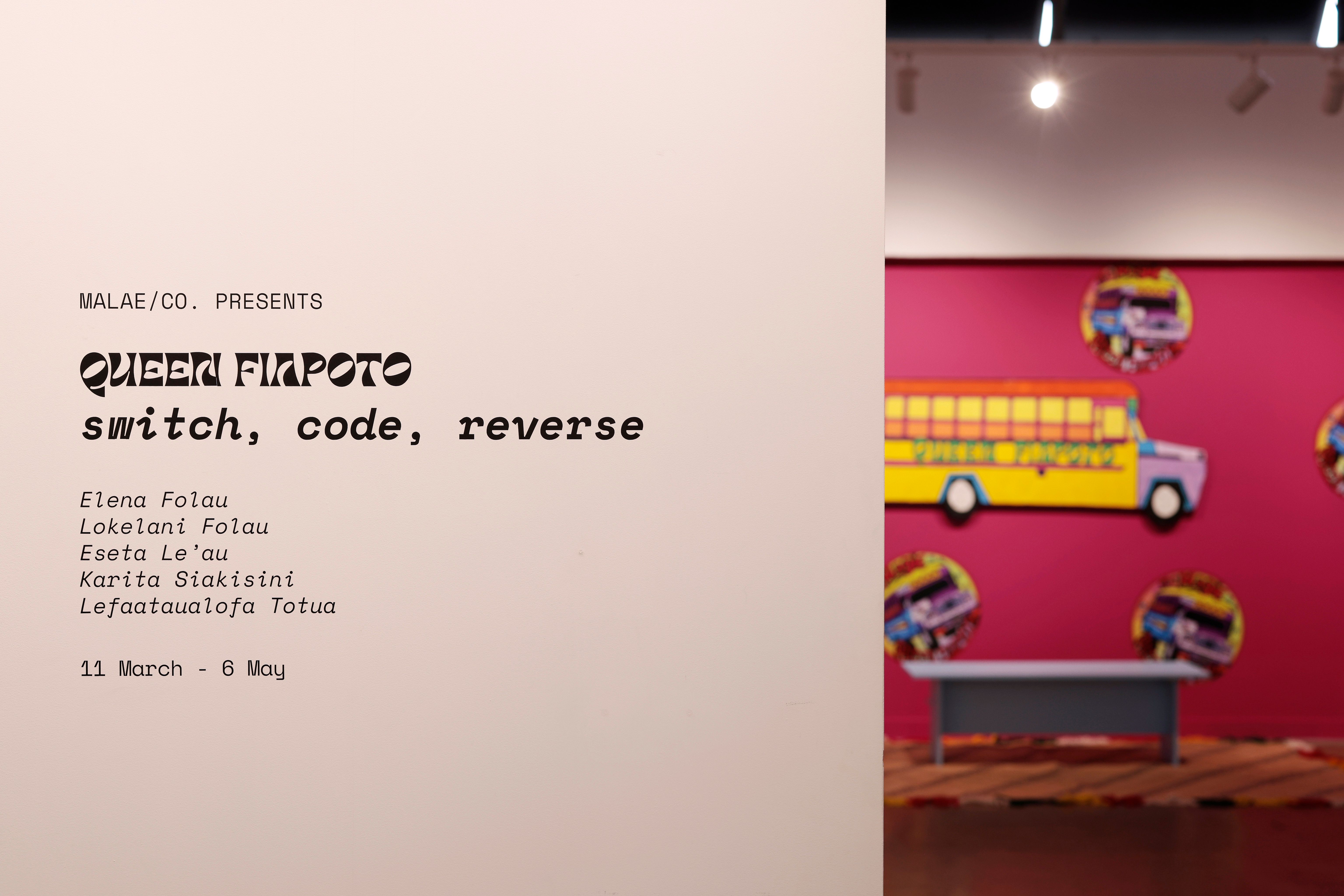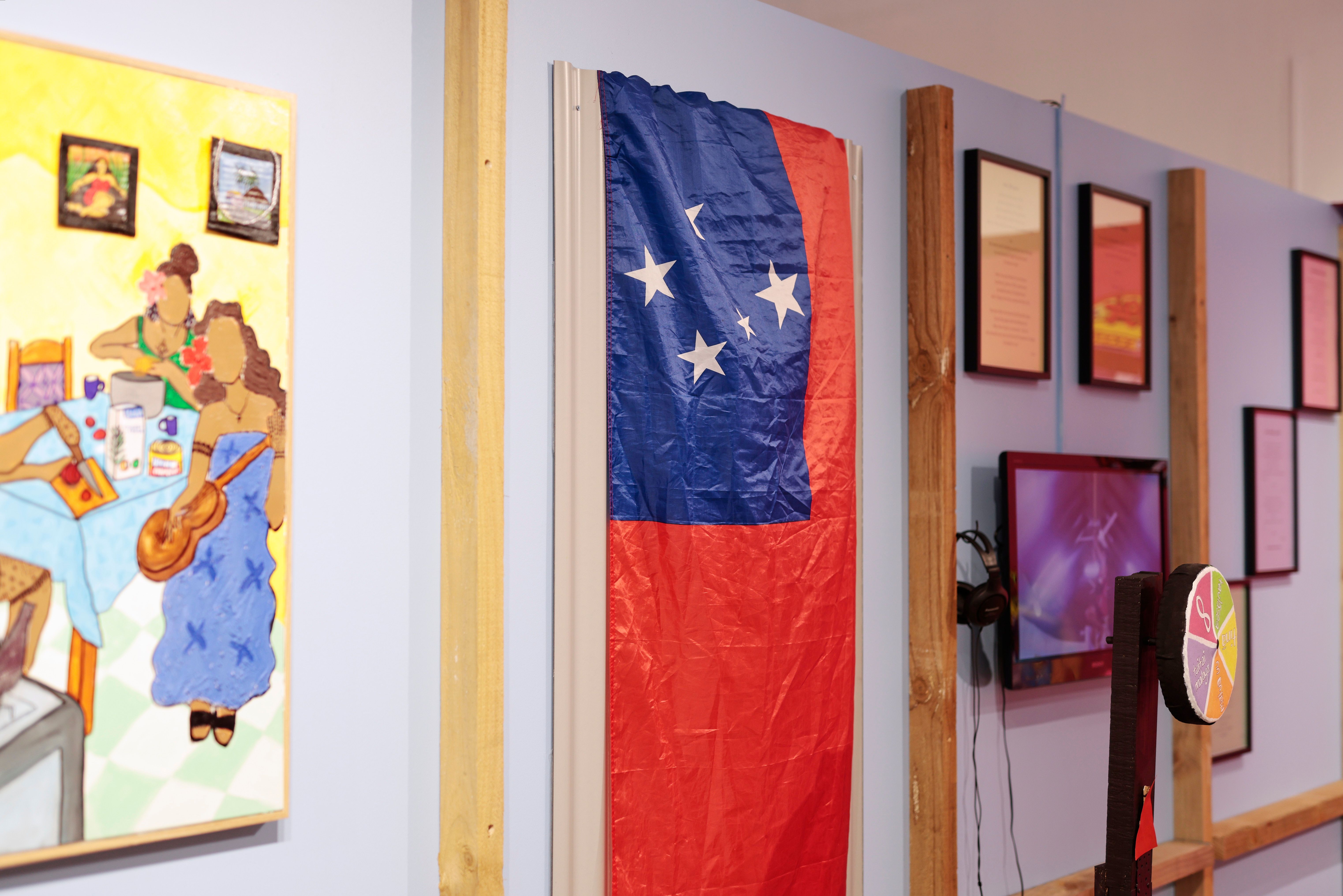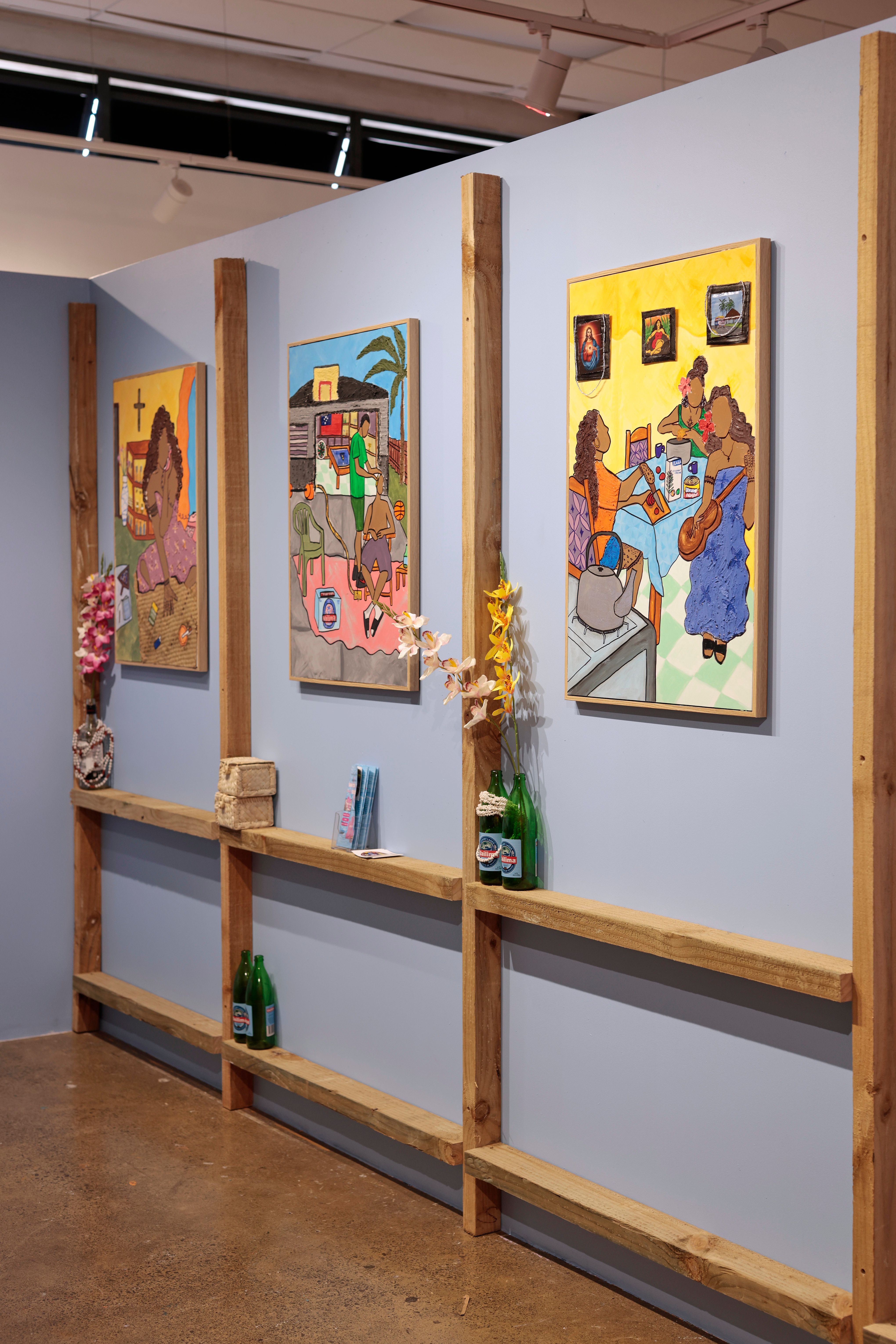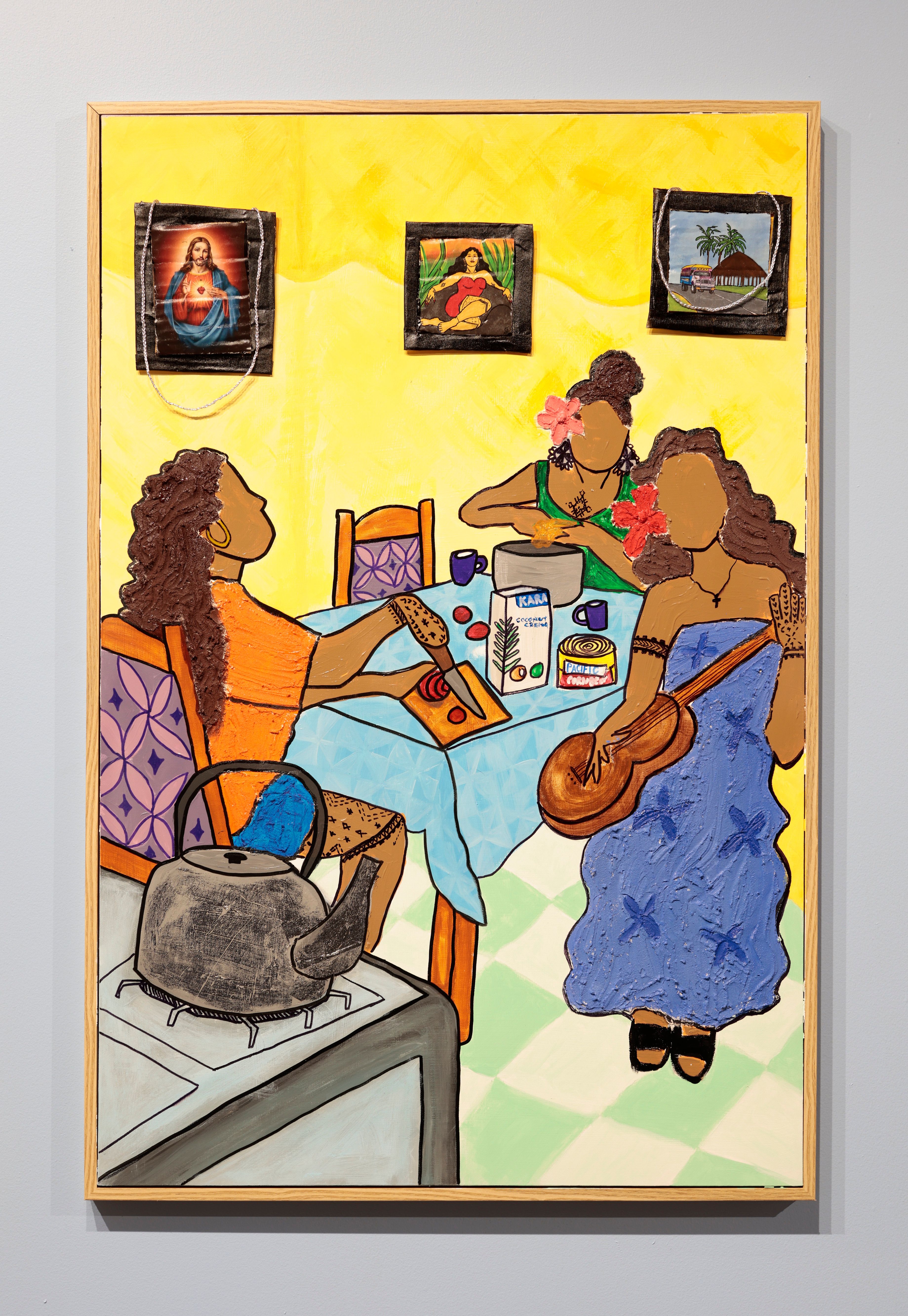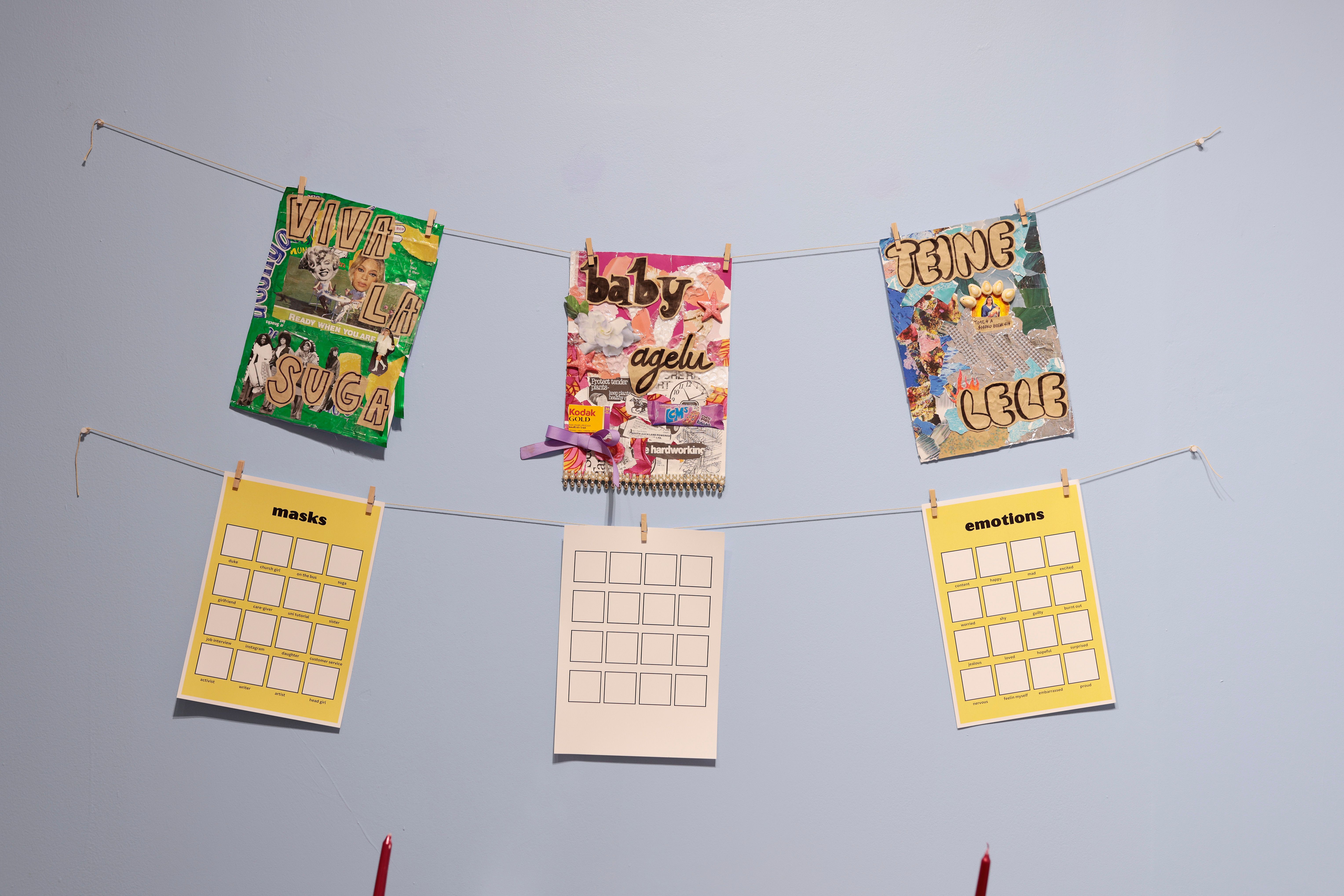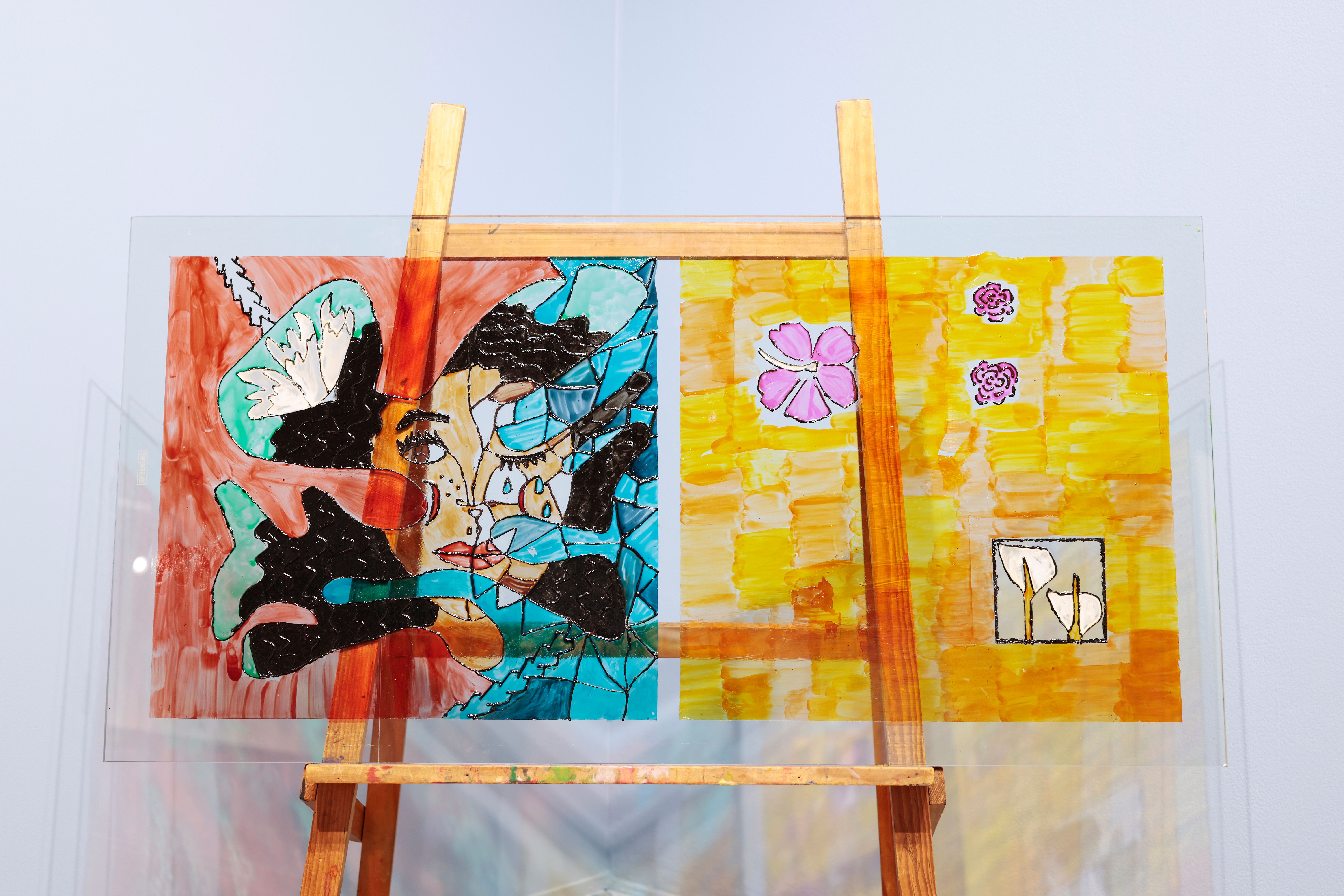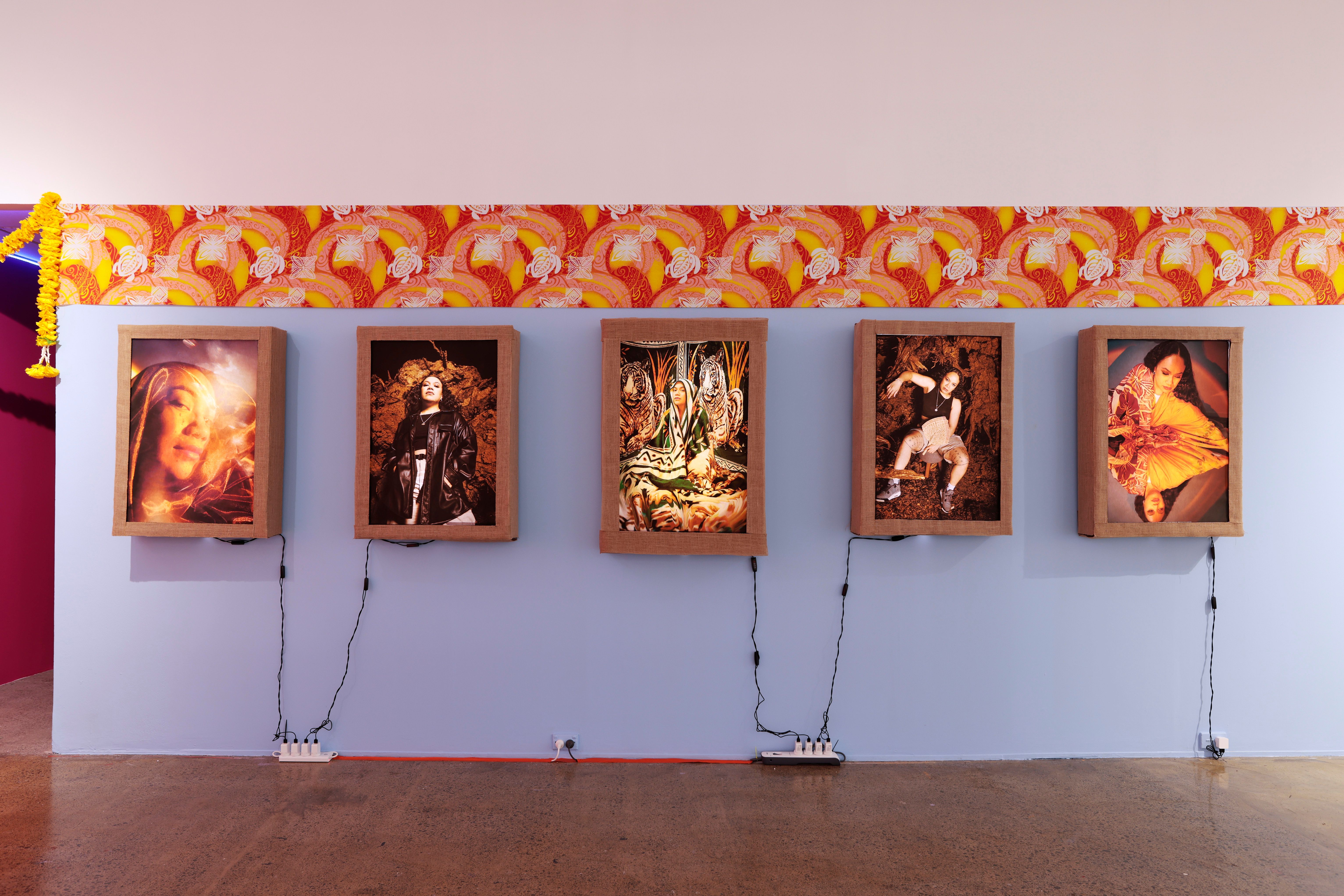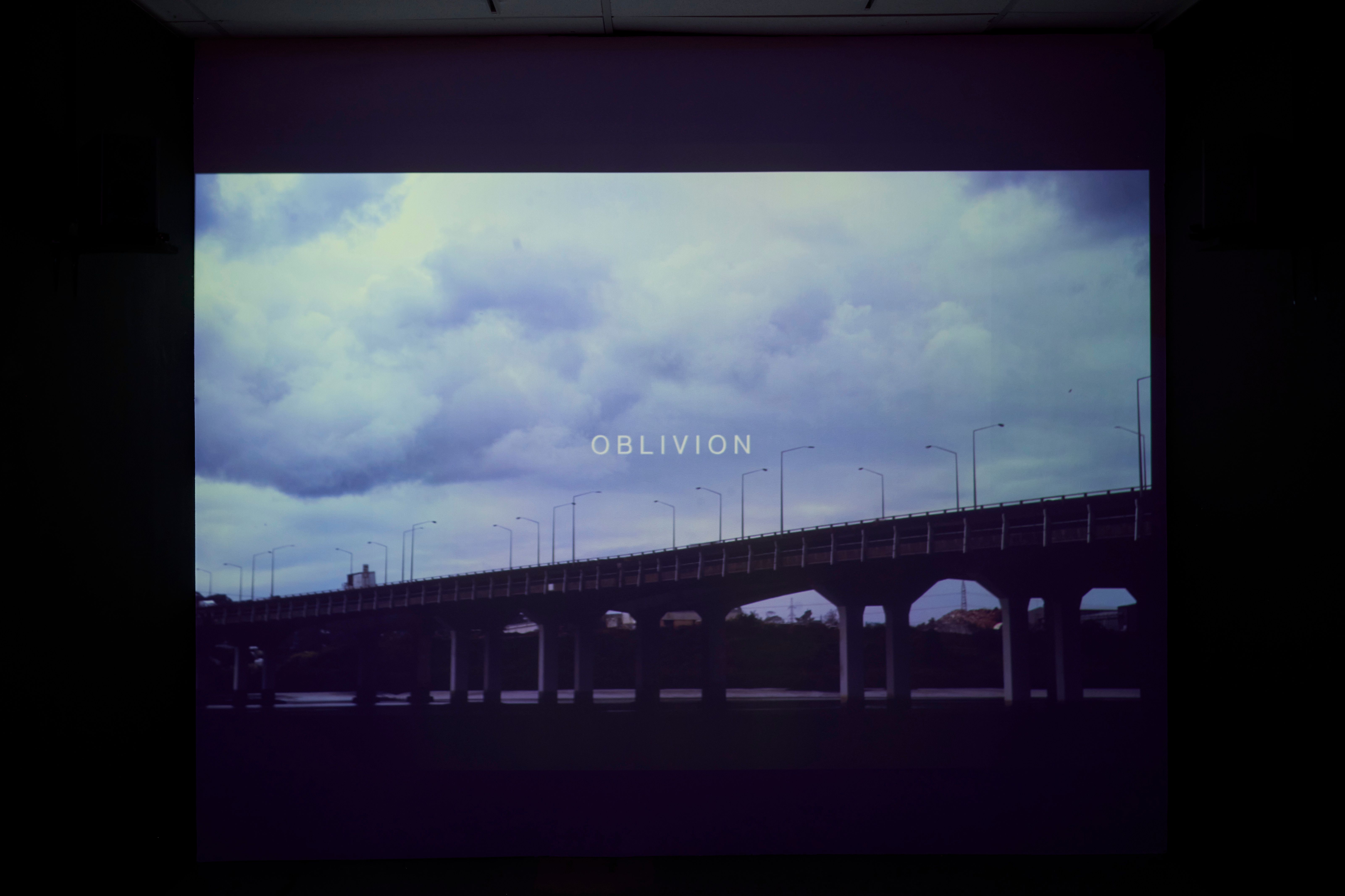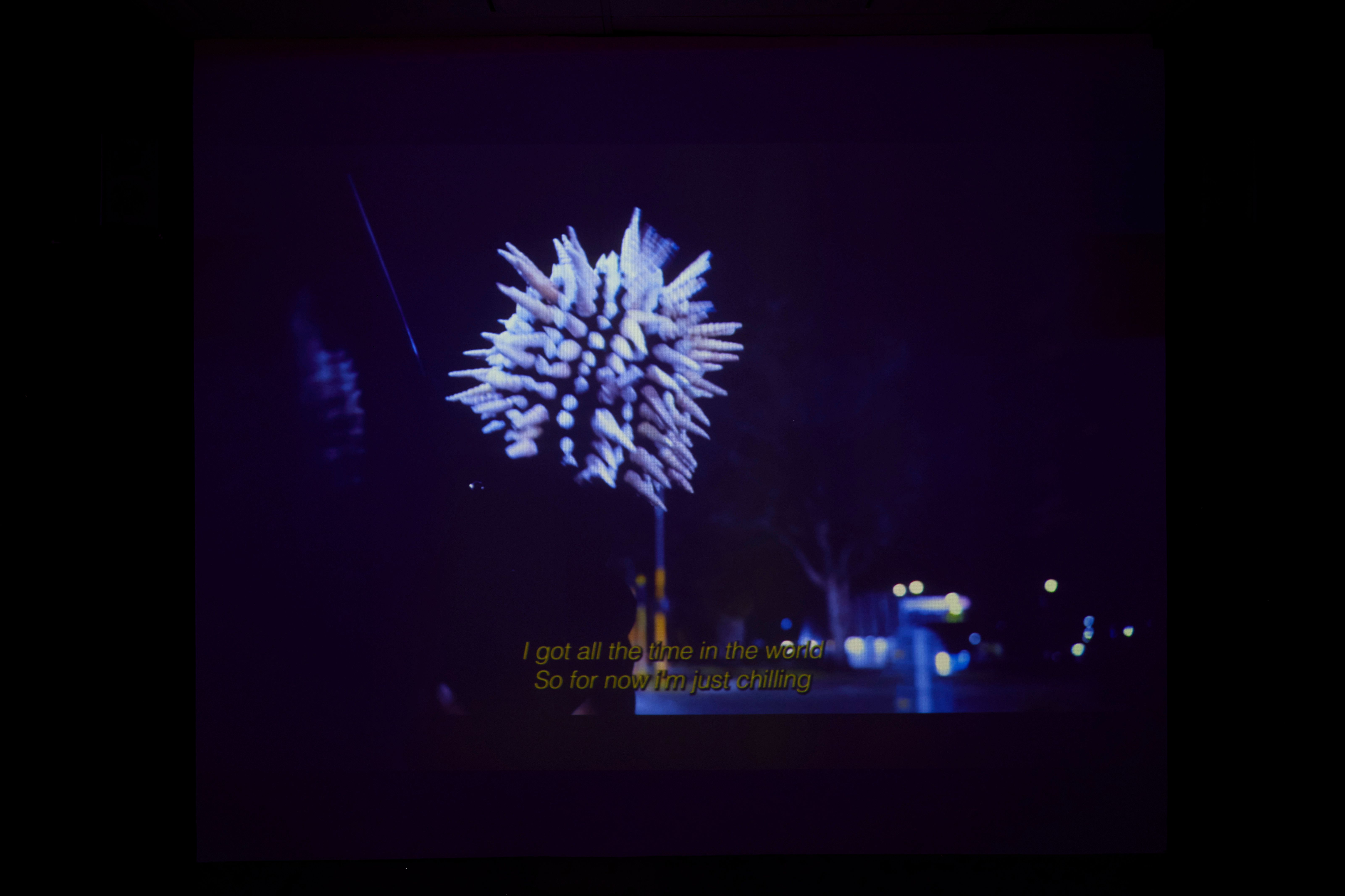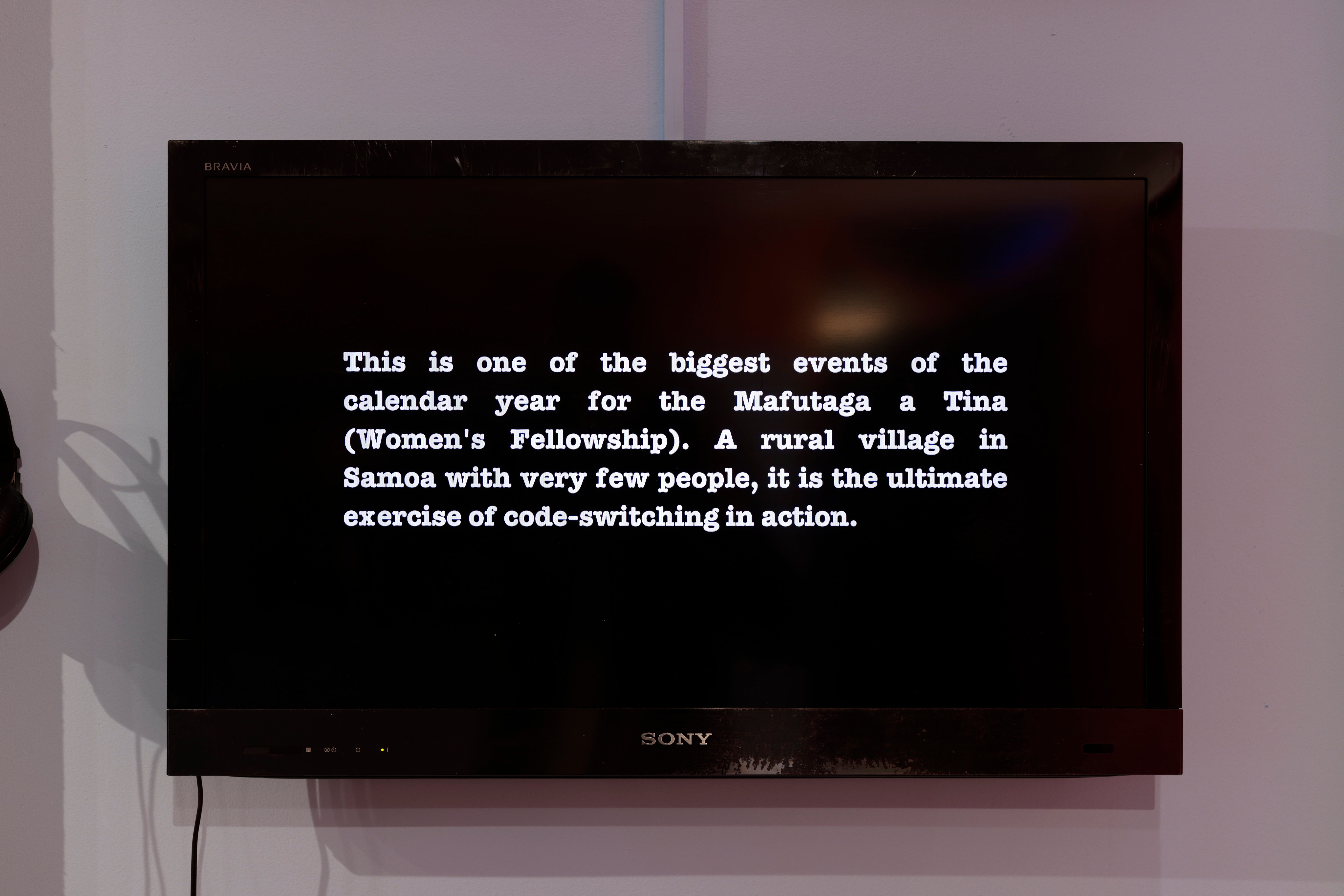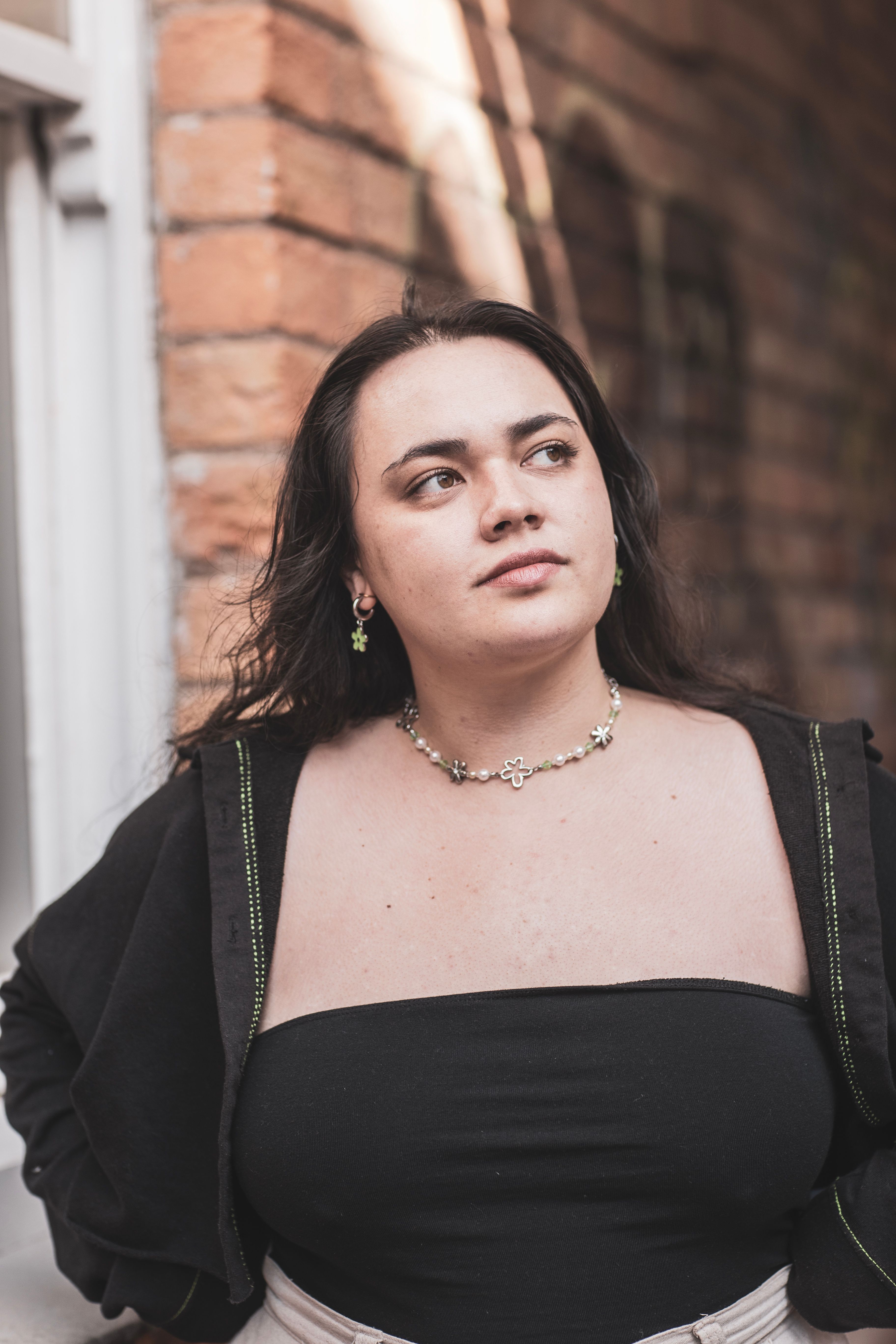A Garage Holds Infinite Worlds
The teine of Malae/Co are back with their exhibition switch, code, reverse at The Magic Queen Fiapoto Bus. Breanna Tugaga-Rogers learns the beginnings of the collective and walks us through the opening night.
“This is a garage, because all great things happen in garages.”
For the Pacific diaspora in Aotearoa, garages transcend the laws of the intended. Here, you will never find a parked car; nor, despite what the country’s most ignorant may think, will you find a gang to join. Unless, of course, it’s the Queen Fiapoto gang.
For us Pasifika, the garage is multidimensional. A space of infinite possibility.
The teine of Malae/Co share space with me as we kōrero about the vision they have turned into reality: The Magic Queen Fiapoto Bus. We sit around a vacant pool table in Karita Siakisini’s South Auckland garage, eating a feed we made together in her kitchen. When visiting a Pasifika household, you’re guaranteed to leave with a full stomach and a smile plastered across your face. With Malae/Co, a feed is a promise they never break.
In the garage, the Sāmoan flag hangs proudly beside us, surrounded by a few fairy lights and art supplies scattered across one of the tables. Karita tells us that this is her safe space – her garage is her malae. It’s where everyone comes together.
Our South Aukilani garage is where we celebrate Christmas and New Year, and hold boxing training
Malae/Co was born in the depths of Karita’s Ōtautahi garage back in 2017, through drawings in a sketchbook. She crossed paths with local Indigenous artist Hōhua Ropate Kurene, and they bonded over their shared connection of being “kids on the fence of the diaspora”, knowing all too well the difficulties of navigating the different worlds of both the Islands and Aotearoa.
Hōhua connected Karita to other talented Sāmoan creatives who he knew had vision, and from that point forward, everything started to align. Elena and Lokelani Folau, Eseta Le‘au, Lefaataualofa Totua and Karita formed Malae/Co: a multidisciplinary collective of artists who are the daughters of transition between Aotearoa and Sāmoa. They say they are all rightful Queen Fiapotos.
The girls tell me the garage is not just a garage, it’s another room, a living space. It’s where Karita’s mum celebrated her 21st birthday decades ago. It’s a dance studio for siva Sāmoa practice, where Taualofa had family parties and everyone congregates for fa‘alavelave. For my aiga, our South Aukilani garage is where we celebrate Christmas and New Year, and hold boxing training. It’s where we farewelled my 18-year-old cousin before he left to play rugby in Japan.
We, Pasifika, are resourceful in the ways we utilise what’s already around us.
The Queen Fiapotos echo my thoughts as they talk, describing how we, Pasifika, are resourceful in the ways we utilise what’s already around us. It’s something our generation learnt from our grandparents, who migrated across the ocean from the motherland and carved out a life here for us despite the obstacles they faced.
The seeds of The Magic Queen Fiapoto Bus were planted in the garage. Inspired by the bright Queen Poto buses back in Sāmoa and The Magic School Bus book series with the fabulous Ms Frizzle, the women of Malae wanted to create a world that transported you to different spiritual planes.
Queen Fiapoto: switch, code, reverse at Tautai. Photo Credit: Ralph Brown
Boarding The Magic Queen Fiapoto Bus at 300 Karangahape Road, I was transported to a plane where time stood still. It was the opening night in the middle of March and everyone was buzzing with excitement on their Saturday night out in Auckland City.
Tautai, a gallery and creative space that has been championing the Pacific arts in Aotearoa since the 1980s, greeted me with little Sāmoa. There was no better place to showcase the flowers that bloomed from the seeds our grandparents planted many decades ago, the little pieces of Sāmoa they brought with them to create homes in the strange new worlds they migrated to.
The Magic Queen Fiapoto Bus was lit up with bright, vibrant colours at every turn. Empty Vailima bottles and ato laufala (woven bags) were dotted around the space, and a fala mat lay underneath a pale-blue bus seat right under the eye-catching bus sign.
Samoa flag. Photo Credit: Ralph Brown
This bubble I stepped into was filled with cheerful chatter and the comfort of Islander laughter. DJ Vercetti was spinning jams you’d hear at a family gathering growing up – Aaradhna’s ‘Down Time’ and Pacific Soul’s ‘Musika Malie’ – transporting me back in time without ever leaving the room.
The spatial design is meant to feel like home, Karita tells me. Goal achieved, as I saw the last century of homes, especially the garage, of Pacific people in Aotearoa laid out in front of me.
Throughout our conversation about the exhibition’s opening night, as we hear from each artist, the girls of Malae/Co tell me this is also the first time they’ve all heard the ‘whys’ behind each other’s creations, a special shared experience for all of us. For me, it is a privilege to be welcomed into their space and to hear the heart-warming stories that inform their art.
Karita Siakisini
The first thing to catch your eye on The Queen Fiapoto Bus are three brilliantly coloured paintings lined up next to each other. It’s hard to believe Karita when she tells us she hadn’t been painting for years before creating for Malae/Co. It’s clear her brush strokes are a God-given talent.
The little Sāmoa of Manurewa by Karita Siakisini. Photo Credit: Ralph Brown
The little Sāmoa of Manurewa showcases scenes familiar to Sāmoan New Zealanders: the aunties sitting around the kitchen table prepping dinner, the boys with their makeshift barbershop in the garage driveway and the little rebel smoking cigarettes on her mum’s fala mat.
The paintings emanate a deep warmth of nostalgia, as Karita weaves the memories of people and places that make her who she is. The vivid colours breathed life onto the canvas, and I could see the figures moving as if I had been absorbed into a far-away memory. It was like a loving embrace of a time I’ve always yearned to return to but never could, until that night. The paintings and their colours are evocative, and mirror my own childhood reflection; with bright eyes and a romantic lens, when your village shelters you from the harshness of the real world.
The little Sāmoa of Manurewa by Karita Siakisini. Photo Credit: Ralph Brown
Karita says the paintings are inspired by “the life my grandma gave me”. Looking at her creations gave me a moment to appreciate the colourful upbringing my aiga provided, such as playing outside with my cousins for hours while the oldies chatted about the serious things we were oblivious to. Just being able to be a kid. It was only in my adult years that I discovered this luxury isn’t something every child is able to have.
Hearing Karita share the intentions behind her art and all that her grandma gave her, the girls and I are nearly brought to tears, as nothing truer has ever been said about the children of the Pacific diaspora.
Lefaataualofa Totua
In another corner sits a brown set of drawers, decorated with glassware, books and a picture of baby Lefaataualofa and her namesake, Nana Lefaataualofa. Hanging above the drawers are three collages, mix-and-matched to represent the very essence of Taualofa herself.
Viva La Suga, Baby Agelu and Teine Lele by Lefaataualofa Totua. Photo Credit: Ralph Brown.
One is made out of a green Bongo chips packet, a staple snack for Pacific Islanders, with magazine cut-outs of famous women like Beyoncé and Marilyn Monroe. The other is mixed with a range of textures, such as a nostalgic LCMs wrapper, a thick beaded necklace and a Kodak camera label, along with newspaper clippings of words like ‘South Auckland Powered’. Each is labelled with self-proclaimed titles: Viva La Suga, Baby Agelu and Teine Lele.
Collaging is an artistic practice that represents different versions of herself, something she has been doing since she was 12, to help her cope with and process feelings, Taualofa explains. The collages exhibited here mark the turning of a new page, as it’s no longer just a coping mechanism but a way of embodying her inner being, she adds.
church girl, caregiver, activist, girlfriend, shy, worried, hopeful
Below each collage are calendar-like grids that, instead of dates and days, showcase different words that represent the masks Taualofa had worn throughout her life and the emotions she has carried: church girl, caregiver, activist, girlfriend, shy, worried, hopeful.
I fully immersed myself into the feelings she poured into her work because, as a Sāmoan woman, I felt deeply connected to her personal creation. We all wear different hats and alternate masks depending on the space we’re in, and sometimes it feels constant. Viewing this, I was enveloped in this feeling of safety because it felt like a slice of home.
Taualofa wanted to bring her nana with her into the space, because she’s her reason – her queen. This was special and heartwarming to see, as the set-up reminded me of my own nana’s room. To see this in an exhibition space brought a refreshed sense of beauty. While a set of drawers in Nana’s room is just a simple object at home, the gallery spaces reminds us it’s also art. Seeing this made me realise there’s not much separation between the two because, when you really think about it, what our nanas have given us is art, it’s beauty, it’s the gift of life.
Placed next to the drawers is the star of the show – a striking stained-glass piece. For Taualofa, this piece represents the two masks she had been wearing, shown in the split design, and the end of a healing experience. One side is almost shattered in the way that it is painted, with powerful shades of moody blue and red; the other is a distinct yellow with flowers, showing both beauty and pain in one glance.
Elena Folau
As I moved around the room, five powerful photographs suddenly demanded my attention.
Illuminated by DIY lightboxes, the works allow Elena’s background as a former architecture student to shine through as bold shades of saturated orange and brown dominate the walls. Within these frames stands a strong and fierce Sāmoan woman, highlighted in different ways through each photograph.
In one, the model is fully wrapped in a patterned fur blanket you’re guaranteed to find in every Island household (one is sitting on my bed as we speak), bordered with more tiger-patterned blankets. She holds a stone-cold stare that matches the ferocity of the tiger. Another is of the model in a black leather jacket, shot from a low angle as she stares down the lens with a certain fearlessness, surrounded by earthy bark that creates a formidable background. A patterned yellow-orange border frames the top of the walls, directly above the photographs, matching the intense orange in some of Elena’s pictures, creating a strong and cohesive stance.
The model is Elena’s sister, and these photos are dedicated to their dad, who passed away a few years ago. If their father ever came back, Elena says, she hopes these images would serve as a visual representation of who they’ve grown into – “This is us.” Through these photos, Elena explains, she wants to show that evolution has happened, and it’s still happening.
With grief being the main driving force behind her photography, Elena wants to show the intersectionalities of her identity through the feeling of loss. With self-assertive depictions of movement that are feminine but strong at the same time, Elena’s photographs reflect the resilience she and her family have had to carry with them after her father’s passing.
evolution has happened, and it’s still happening
Elena’s craft wields power, through her words and striking photos, and even without the viewer knowing the story behind her art, these photos are loud with strength and spirit. I left the exhibition that night with a deep admiration for her work, which was only further strengthened when she opened up to the girls and I about the connection between her dad and her art.
Lokelani Folau
In a room tucked away at the back of the exhibition lies a cosy theatre space, filled with a few bean bags and a snug couch. A mesmerising film flickers across the screen, showing slow-motion shots of confident, beautiful women contrasted with fast-cut editing.
Produced, directed, edited, styled and make-up done by Lokelani, this is such a creative way to display her versatility and the range she possesses. I stood, stunned by the sheer badassness of it all, truly in awe of the cinematography and fierce looks served. There are familiar scenes shot under Māngere Bridge in a music-video-style visual, very reminiscent of Beyoncé’s Lemonade era, with yellow subtitles etched at the bottom of the screen.
Oblivion by Lokelani Folau
Three different versions of herself are represented, says Lokelani. The first is a stunning seashell-covered mask representing her guarded self, the second is a shell necklace and a bold red lip to show she’s more open but not giving 100% away, and last, a jaw-dropping red look that boasts confidence, showing the side of her reserved only for special people, she explains.
We all sometimes feel like the main character in the music video we call life, so it feels powerful to see Lokelani execute this for herself. To see her have authority and agency over her own narrative is influential, an absolute dream to lay eyes on. I had to tell Lokelani right after seeing it, “You’re THAT b*tch!”
Oblivion by Lokelani Folau
I remember the Queen Fiapotos telling me that they’re the shy girls, the ones who played it safe as kids. Looking at their art, you wouldn’t think that’s the case. It was like getting a glimpse into the unlimited potential of their absolute best selves: thriving and leaving no crumbs behind.
Eseta Le‘au
During my kōrero with Malae/Co, I discover Eseta is a relative of mine through Nana Alitasi – as if this experience couldn’t get any more wholesome. Crossing paths with the Queen Fiapotos has truly been a blessing.
Eseta is a thoughtful wordsmith who is exhibiting five beautiful poems and a touching home video of the motherland as a homage to all the women in her life and the different roles they play; they’re life-givers through motherhood; caretakers as sisters, cousins, aunties; they’re guides, healers, providers, makers, protectors, leaders, the glue and so much more.
The juxtaposition of seeing this expressed in a visual and written style was incredibly engaging; I was able to read her poetic play with words, and then watch this reflected on screen. The contrasting mediums provided an immediate connection to her expression of the multifaceted identities of Sāmoan women.
Coming from a matriarchal family, Eseta says she tries to reflect all the cool things women do that are constantly overlooked. The different roles we, as Sāmoan women, play are a privilege but, at the end of the day, it all comes from alofa, she adds. Reading her words, I felt she really captured the notion of tautua (duty) in a way many Sāmoan women understand but perhaps have never been able to put into words.
Her art feels like a celebration of all that Sāmoan women do, who, truthfully, never really get that acknowledgement. Viewing her work gave me a moment to appreciate the women in my life who constantly move mountains for myself and our loved ones, regardless of credit given or not.
The roles we take on as Sāmoan women are not a burden but a birthright, Eseta says. It’s second nature, because it’s not something we do, it’s just who we are, she adds.
Her responsibility weighing as heavy / as the crown she bears / one she did not ask for / but was bestowed for a myriad of reasons / birthright, tautua, role / they look to her guidance / and approval in matters of complexity / trusting her to bring order / to chaos An excerpt from ‘taitai malaga | guide’ by Eseta Le‘au.
I loved so many things about being onboard The Magic Queen Fiapoto Bus, but the one thing that struck me the most was the number of family members who came out to view their work. Seeing our Pacific community across all generations in art spaces, supporting their aiga’s artistic talents, is nothing short of transformative.
The Magic Queen Fiapoto Bus is purely and utterly Sāmoan; however, anyone who has roots in the Pacific Islands can connect to the art here deeply, as we have all dispersed into worlds that differ from the one of our ancestors.
Like the garage, we Pasifika are fluid. We do not come in one fixed form, nor can we be defined by a single term. Fa‘afetai lava Malae/Co for this tenderly penned love letter to the Pacific diaspora.
Feature image courtesy of Malae/Co, animated by Anastasia Burn

